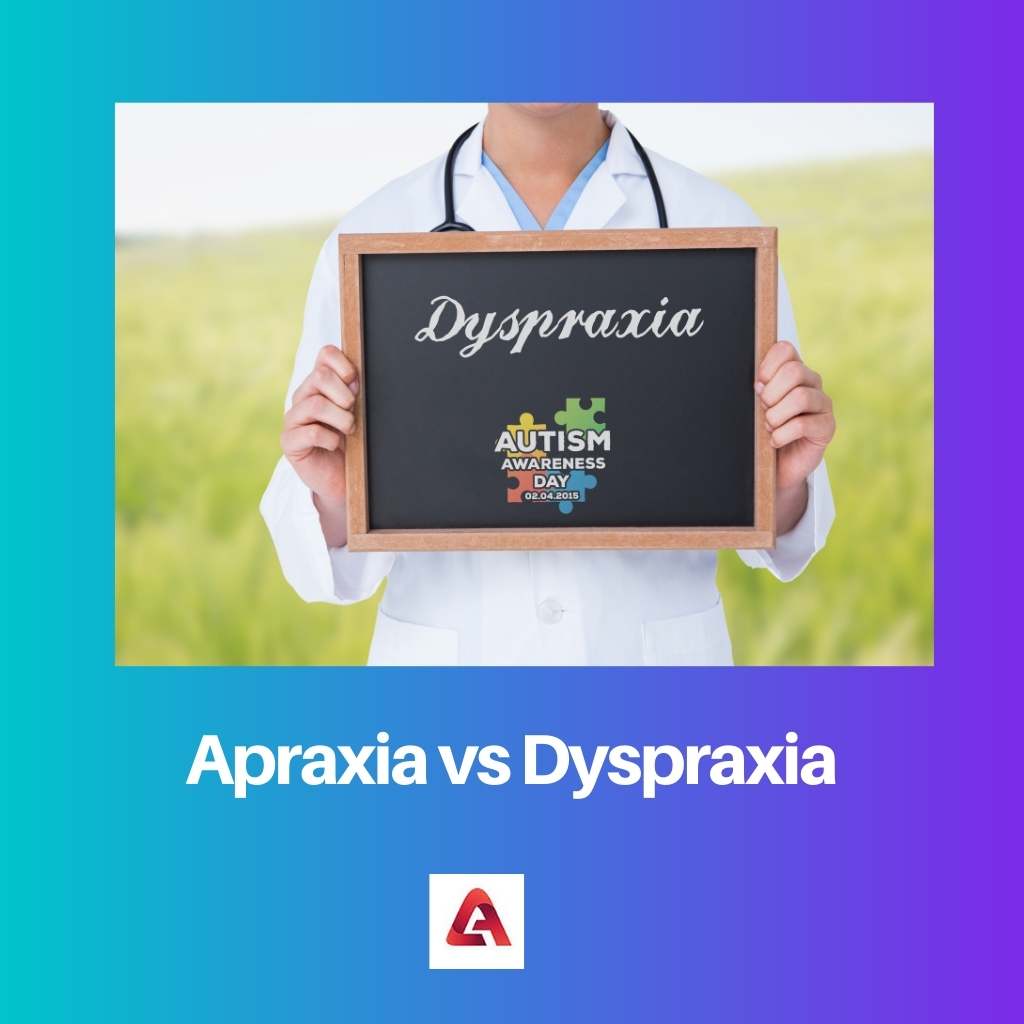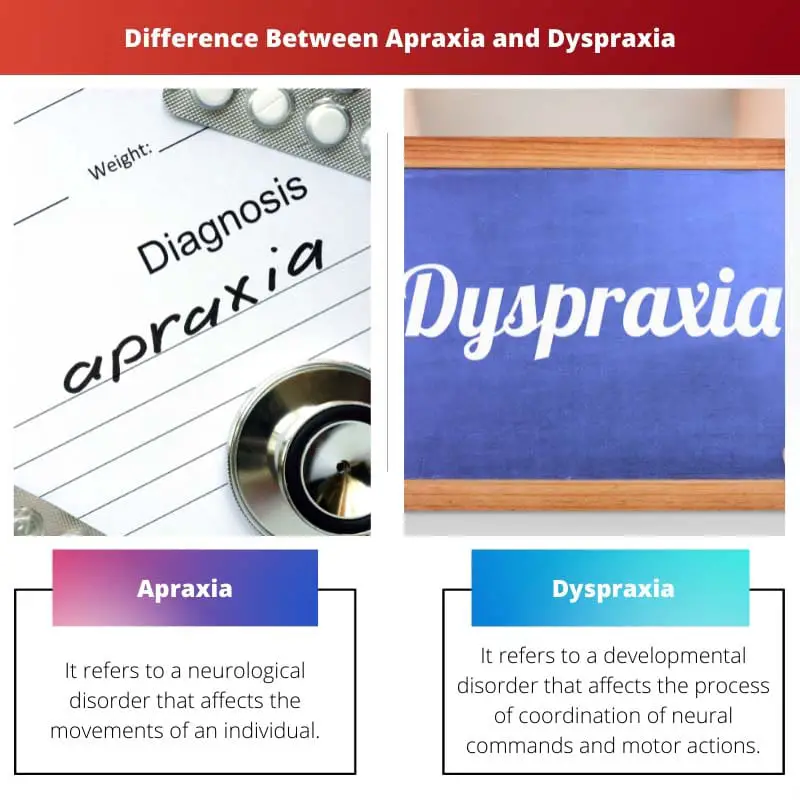The disorders affecting the brain and its communication with the nervous system are referred to as neurological disorders. Some disorders are innate, whereas some are developed after birth.
These disorders mainly result from the brain and spinal cord’s structural, electrical, and biochemical disturbances. Two such disorders include apraxia and dyspraxia.
Key Takeaways
- Apraxia is a neurological disorder affecting the ability to execute skilled movements, while dyspraxia is a developmental coordination disorder.
- Apraxia results from brain injury or stroke, whereas dyspraxia has no known cause but is suspected to be genetic or related to early development.
- Treatment for apraxia focuses on speech and occupational therapy, while dyspraxia treatment includes physical and occupational therapy and educational support.
Apraxia vs Dyspraxia
The difference between apraxia and dyspraxia is that apraxia refers to a neurological disorder, whereas dyspraxia refers to a developmental disorder. Moreover, apraxia affects older individuals, whereas dyspraxia is mainly seen in children aged 0-20 years. Apraxia doesn’t lead to further diseases. In contrast, dyspraxia may result in ADHD.

Apraxia is the condition where a patient is unable to make skilled movements.
Although the person is willing to carry out the specific body movement, he cannot do it because the brain fails to deliver proper commands to the muscles.
Moreover, the muscles even fail to receive the commands. Some neurological issues in the brain lead to apraxia.
Dyspraxia is another neurological disorder where the symptoms resemble that of apraxia. It can affect one or all of the core areas of a child’s development, such as physical, sensory, motor, mental, and emotional.
One in every fifty children suffers from dyspraxia in some part of his life. A child with dyspraxia may also develop other conditions, such as ADHD (Attention Deficit Hyperactivity Disorder).
Comparison Table
| Parameters of Comparison | Apraxia | Dyspraxia |
|---|---|---|
| Meaning | It refers to a neurological disorder that affects the movements of an individual. | It refers to a developmental disorder that affects the process of coordination of neural commands and motor actions. |
| Causes | Apraxia is mainly caused as a result of strokes, head traumas, dementia, tumors, etc. | Dyspraxia is mainly caused as a result of neurological disorders in the left hemisphere of the brain. |
| Symptoms | The symptoms of apraxia include the individual’s inability to complete some specific actions. | Although the symptoms of dyspraxia vary with the child’s age, the common symptoms include feeding problems, irritability, weird body positioning, and others. |
| Diagnosis | Various tests testing the individual’s communication skills and coordination abilities are done as a part of the diagnosis test. | Various medical tests testing the child’s mental abilities and motor skills are done as a part of the diagnosis test. |
| Treatment | Physical therapy, one-to-one sessions, occupational therapy are the most commonly used treatments of apraxia. | Speech therapy, regular exercise, or performing the same actions are the treatments to cure dyspraxia. |
What is Apraxia?
Apraxia is a neurological disorder wherein patients struggle to make normal motor movements and gestures.
The person has the capacity, desire, and strength to do a particular task but fails to execute his desires.
Some examples of inability to perform any activity in people with apraxia include the inability to tie shoelaces, talk properly, etc. Apraxia is again categorized into different types depending on the affected body organ.
Limb-kinetic apraxia is when a patient cannot make motor movements requiring the involvement of legs, fingers, arms, and toes.
Ideomotor apraxia refers to the condition when a patient is incapable of reciprocating the commands given by the brain into action.
Conceptual apraxia, resembling ideomotor apraxia, refers to the condition where an individual is unable to understand the functioning of various tools.
Ideational apraxia refers to the condition where an individual is unable to lay down a plan for making a specific movement.
In buccofacial apraxia, also known as facial-oral apraxia, the patient is unable to show or make any movements involving facial bones and muscles.
The patient cannot draw or make even simple figures in constructional apraxia. In oculomotor apraxia, patients are unable to make eye movements.
Generally, in all kinds of apraxia, the patient is unable to establish coordination between the commands given by the brain and the muscles of the body part.
What is Dyspraxia?
Dyspraxia, also known as DCD, refers to a developmental disorder wherein a patient is unable to make gross movements and coordinate the finer movements.
It’s the earlier stage of dyspraxia, which affects an individual’s day-to-day life. About 6-10% of children get detected with dyspraxia.
Moreover, in many cases, the symptoms of the disease are so mild that they go ignored because the disease isn’t detected. Generally, boys are at higher risk of developing this disease than girls.
Dyspraxia is also categorized into various types. In ideomotor dyspraxia, the child faces problems in integrating smaller steps to complete a complex action.
In ideational dyspraxia, the child is unable to plan or sequence for the completion of an action.
In verbal dyspraxia, the child is unable to make proper movements of lips, mouth, and tongue, resulting in improper pronunciation.
In constructional dyspraxia, the child faces problems in the arrangement of objects.
In gait dyspraxia, the child is unable to walk properly, and in dressing dyspraxia, the child has no proper dressing sense and sequence. The symptoms of dyspraxia vary with the age of the child.
As a result of these symptoms, the education and development of the child are highly affected. These symptoms are noticeable in the child’s behavior.
Main Differences Between Apraxia and Dyspraxia
- Older and middle-aged people are at higher risk of getting apraxia. On the other hand, dyspraxia mostly affects children and teenagers.
- The chances of apraxia are 1 or 2 in every 1000 individuals. In contrast, the chances of dyspraxia are 1 in every 50 children.
- Head strokes, tumors, and other severe injuries are the causes of apraxia. Any disorder in the brain, especially in the left hemisphere, will result in dyspraxia.
- The most common treatments for apraxia include occupational and physical therapies. But, the common treatments of dyspraxia include speech therapy and regular repetition of actions.
- Apraxia has no hereditary roots. While dyspraxia has hereditary roots and can pass from the parents to the children.


The table comparing the meaning, causes, symptoms, diagnosis, and treatments of apraxia and dyspraxia is well-structured. It is a great way to understand the key differences between the two disorders.
The detailed descriptions of different types of apraxia and dyspraxia provide a comprehensive insight into the disorders. The side-by-side comparison is particularly informative.
The article offers specialized and thorough knowledge about apraxia and dyspraxia. It’s a must-read piece for anyone looking to understand the complexities of these neurological disorders.
The article helps to clear the confusion between apraxia and dyspraxia. It is informative and provides a deep understanding of both neurological disorders. The references support the information presented.
The article is very interesting and well written. The explanations are clear and easy to understand, it is a very complete piece on neurological disorders.
Decent article from an educational standpoint, however, it lacks a bit of a human touch to really connect with the readers. More real-world examples and patient stories would enhance the overall piece.